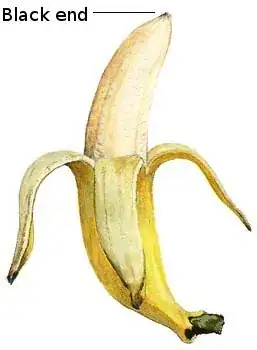I was always told that I should cut off the black ending of a banana before eating, because it would be dangerous. Sources for this claim can for example be found here (though that source is actually rebuking the claim, but I was not able to find any other online sources). Is it indeed true that eating this black ending is unhealthy?
-
4Here's some [evidence that this is a 'notable claim'](http://girlshowtoimpress.com/youll-get-sick-if-you-wont-cut-off-a-black-ending-of-the-banana/) i.e. that you're not the only person who has been told that a black end of banana is dangerous. – ChrisW Aug 16 '14 at 20:52
-
4What is the black end of a banana? – Flimzy Aug 16 '14 at 21:10
-
2@flimzy: I assume it's the end opposite the stem, which is usually dark in color. – Nate Eldredge Aug 16 '14 at 21:14
-
@Nate Eldredge AFAIK if you remove the skin, the banana is white on the all ends. Or is this a question about a practice of eating bananas with skin? – Anixx Aug 17 '14 at 11:17
-
1@Anixx If you remove the skin, the banana is not always perfectly white on the ends. This is not a question about a practice of eating bananas with skin. – Adam Stelmaszczyk Aug 17 '14 at 11:38
-
3I think I normally open the banana from the stem end and don't eat the black bit because it has a bad texture at least, and IIRC doesn't taste nice anyway. – Mark Hurd Aug 23 '14 at 16:42
-
6You should open your bananas the other way around, it's much easier. – Drahcir Sep 02 '14 at 10:18
-
The answer to this could be the same as the answer to the citrus peel question. Fda says nothing therefore safe? Just a little boring. – Spork Sep 05 '14 at 16:07
-
1Here's as far as I got: Banana *peel* browning [is caused by enzymes](http://kukr.lib.ku.ac.th/Fulltext_kukr/KU0296171c.pdf). I can't find a source for the *pulp* browning; perhaps it's the same? Bananas begin growing at that "black end", which could mean it consists of remnants of the flower. I was looking for a time-lapse video of a growing banana fruit to confirm this, but couldn't find one. Does anyone know a banana farmer? – Anko - inactive in protest Sep 08 '14 at 20:51
-
1@Anko tip rot is completely different and it's of fungal origin, see e.g. http://link.springer.com/article/10.1007%2FBF02980350#page-1 – Sklivvz Dec 21 '14 at 00:03
1 Answers
No, you needn't cut off the end of the banana unless it's rotten.
There are a two main reasons why bananas turn black.
Bananas keep on maturing even when they have been harvested. This happens through enzymes and oxydation and it's part of the normal life cycle of the fruit. In fact, a slightly over-ripe fruit is likely more nutritious because of higher sugar content. If your banana is simply ripening, you can eat it, it's oxidized and not rotten.
In ripening banana (Musa sp. [AAA group, Cavendish subgroup] cv Valery) fruit, the concentration of glycolytic intermediates increased in response to the rapid conversion of starch to sugars and CO2.
Fungi of the Colletotrichum family (and in particular Colletotrichum musae is the banana-specific one) are endemic on vegetables and cause rot. One well known effect is tip rot in bananas. Probably these fungi are not particularly toxic (this is my assumption), but the normal "avoid rotten food" advice applies.
